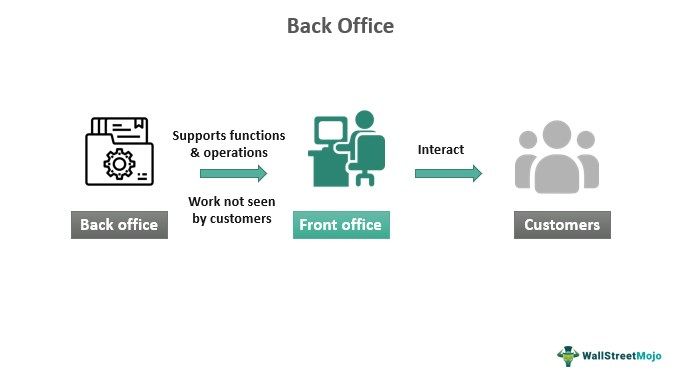Table Of Contents
Back Office Meaning
A back office refers to a section of a company where operations assisting the company's core customer-facing departments are performed. Generally, all operations that don't directly involve clients take place in the back office.

The people working in the back office generally do not interact with the clients but with the front-office personnel. The people working in the back office administer various aspects of the business necessary for most of the company's operations to run successfully, like finance and accounting, human resources, supply chain, logistics operations, and IT.
Key Takeaways
- The back office refers to a section of a company supporting the front office and does not have direct customer interactions.
- It is the supporting division of the business involving human activities and processes.
- It primarily includes administrative duties to aid positions that directly interact with clients. They contribute to the smooth functioning of the front office.
- The types of departments exhibiting it includes finance and accounting, human resources, supply chain, logistics operations, and IT.
- Research, management of facilities, order processing, underwriting, claims to process and accounts maintenance are examples of conventional non-customer-facing operations that carry out consumer demands.
Back Office Work Explained
The back office is commonly defined as where business operations in support of the front office take place. The front office involves facing customers and dealing with them directly. The back office covers various business operations, including human resources, finance and accounting, supply chain and logistics, IT support, etc. The work includes researching, making payments, scheduling receipts, and managing facilities. It includes areas required to make the whole process work smoothly, as this is where all supporting front ends happen. These operations largely involve human activities dealing with inputs and business processes.
The workforce in the back end process information, timely settle deals and manage data. To make customer interaction and commercial transactions easier for the front office, the administration and other support departments give it the necessary paperwork and technical support. Some businesses also specialize in their back-end functioning to provide settlement, clearance, and IT services in addition to accounting and finance services.
Despite not being visible to clients, the back office is crucial to the business since it performs several tasks for the customer-facing departments to give customers the greatest impression of the enterprise. In addition, they deal with all client requirements and play an important role in building a successful organization.
Despite not immediately falling under the umbrella of customer service, these roles are nevertheless in charge of or contribute to streamlining and enhancing the client experience. Whatever the customers' intent, the events that occurred before, during, or following the sale could either improve or degrade their experience, leaving customer-facing positions to deal with the aftermath. Positive experiences at each touch point help avoid customer dissatisfaction with a good end-to-end back-office support system.
Examples
Some of the examples are the following:
Example #1
In a bank, the back office comprises the workforce, positions, or roles that are not customer-facing. A wide range of tasks required to keep a bank operating is included in these positions on the operations side. Loan operations, deposit operations, accounting, compliance & auditing, underwriting, and information technology are a few of these divisions.
Example #2
One of the areas where back office operations are performed is in the order-to-cash process. The order-to-cash (O2C) process includes steps like order management, credit management, order fulfillment, order shipping, customer invoicing, accounts receivable, payment collections, and reporting and data management. Several instances associated with these steps portray back-end functioning.
For example, in order fulfillment, a crucial component is inventory management. Real-time inventory counts should be updated on the sales side to prevent taking orders that can't be fulfilled. Furthermore, if an out-of-stock order reaches fulfillment, it must be noted immediately.
Back Office vs Middle Office
- Purpose: Middle office links back and front office. The workforce falling in the middle section looks into the processing and fulfillment of agreements made during financial transactions. The middle section helps to reduce the complexity involved in business or financial transactions. They also make sure that agreements prepare paperwork. At the same time, the back end works to support or sustain the customer-facing departments.
- Settlement: The departments in the middle section are engaged in settlement preparation. Pre-settlement work comprises decisions about deploying IT resources in the company's three (front, middle, and back) sectors and risk management. The department in the middle of the flow has the best general understanding of how various systems and technologies will interact with one another, as well as the segment that is most aware of the requirements of other departments. The middle office's role now mostly entails processing settlement and post-settlement data to prepare the information flow to other divisions engaged in the support work. At the same time, back office personnel are more into administrative or clerical tasks.
- Examples: The examples of personnel working in the middle section are risk managers and information technology managers. On the other hand, non-customer-facing executives are connected to human resources, accounting, and operations.

